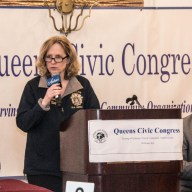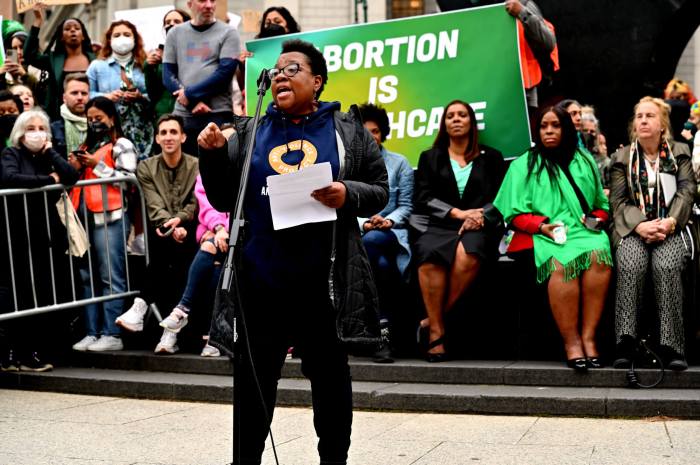By Glenn Ferrara
Big-time film critics are a hungry lot. By the time the Lincoln Center organizers of the 39th New York Film Festival let in the “Second Tier” Press, a good deal of the breakfast pastries laid out in the waiting room was gone.
The yellow card means you need them more than they need you. It also means you are not to be mixed in with the “Top Tier” folks until they have a chance to grab their refreshments and scramble to their seats.
The precise name of this particular pass is the “limited access pass.” It will get you into the screening for free, which is all that really matters, provided you can fit into the auditorium.
Outside of the Walter Reade Theater at Lincoln Center, a line of yellow-passers forms before each showing. About 10 minutes before the particular screening is to begin, the staff (who have been helpful and lovely, for the most part) will let yellow-pass holders in. They will fill the rest of the theater until there are no empty seats, and then some may get turned away (though I haven’t heard of any.).
The safest move is to find a seat as soon as you are let in, drop off a marker to hold your seat (something that you don’t need, like a blank reporter’s notebook), and then make a beeline for the pastry room.
As you can imagine, if the fancy press is hungry, we little guys are ravenous. These baked goods and cups of coffee may be the only food some of us see for weeks. (Rumor has it that a Lincoln Center staffer got too close to a feeding journalist; I hear the poor kid is light one arm.)
After the tornado of yellow-pass holders rips through the complimentary treats, not even a crumb’s crumb is left. That is, left on a table — the floor is another story.
There is nothing grand about the theater, no ornate fixtures or even elegant wallpaper. If not for all the blazers and Dockers slacks, you would think you were in a multiplex. But this tough New York press doesn’t seem to mind. Did I mention it was free.
There are maybe 20 empty seats, it’s hard to tell. Either way, it’s very crowded. The lights dim, the curtain is drawn and we are under way.
After the first week of the festival I have to say that I was a little disappointed. First, this is a relatively small film festival, as film festivals go. Over the course of three workweeks, 28 films were to be shown. Considering there were close to 300 shown at the recent Toronto Film Festival, this was tiny. Also, there were only four original American movies playing (documentaries and reruns don’t count). While I like a good foreign film as much as the next red-blooded American, it still would have been nice to see more home-grown material. Especially since the foreign films in this first week were rather lackluster.
But enough of the festival bashing. Hate to do it, since the organizers have been so kind. Let’s talk about the films.
The first week of the festival had quite a few films that are not really worth mentioning. The next two weeks will have a much nicer batch. But there were two films that deserve some attention.
“Storytelling”
This is director Todd Solondz’s latest blacker-than-black comedy. Solondz (“Welcome to the Dollhouse,” and “Happiness.”) has quickly earned a reputation as a no holds barred filmmaker. He does not know the meaning of “restraint.” His films have been brutal, bizarre and sickly hilarious, and his newest is no different. The film is divided into two unequal parts. The first, “Fiction” is the lesser of the two. Not nearly as developed as the second segment, “Fiction” centers around a couple of would-be writers, Selma Blair (“Cruel Intentions”) and Leo Fitzpatrick (“Kids”), and their formidable writing professor Robert Wisdom (“Face-Off”). It’s best not to give away too much of a Todd Solondz film. And anyway, you might not believe it unless you saw it. I will say this: This is not a movie for the squeamish.
The second chapter, “Non-Fiction,” is a much more developed story. It’s almost as if Solondz, who not only directed but wrote the film, was much more enthusiastic about this segment. You wonder why the second piece wasn’t just expanded and the first removed. In “Non-Fiction” Paul Giamatti (“Planet of the Apes”) plays a struggling filmmaker who follows rebellious high school student Mark Webber (“Snow Day”) around for a documentary film. Webber’s family is made up of the usual Solondz suburban monsters. Leading the way in excellent form is John Goodman (“The Big Lebowski”) as the easily hypnotized patriarch.
Again, you won’t believe what eventually happens, which is just one reason why you should see this film. Solondz fans will not be disappointed.
“Va Savoir”
This is a much-hyped film because it comes from French director Jacques Rivette. Rivette is the least known member of a 1960s group of important French filmmakers that include Godard, Rohmer and Truffant.
Translated as “Who Knows?” this new film is nothing remarkable — the story is simple and predictable. It almost plays out like a soap opera.
An actor (Sergio Castellitto) and his actress wife are in a play in France, where the actresses’ old boyfriend still lives. The actress (Jeanne Balibar) isn’t sure if she still loves her old flame and can’t help seeking him out. The old boyfriend (Jacques Bonnaffe) still loves her, but is now married to a dance instructor (Marianne Basler) who is being seduced by a shady character (Bruno Todeschini) who just happens to be the brother of a young girl (Helene De Fougerolles) who is helping the actor look for a lost manuscript.
This goes on for nearly three hours. If cut down, this romantic comedy might have been tolerable, but the length and the pace make it hard to endure.
I’ll tell you about the second week of the Festival in a near-future Qguide edition.
Reach Qguide reviewer Glenn Ferrara by e-mail at Timesledger@aol.com or call 229-0300, Ext. 139.




























